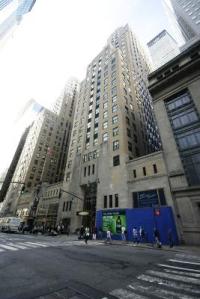Coalition Releases Midtown East Study, Preservationists Balk
By Gus Delaporte February 28, 2013 7:30 am
reprintsMidtown 21C, a coalition heavy on construction companies and labor organizations advocating for the rezoning of Midtown East, yesterday released a study evaluating the area’s historic assets and development history. The focus of the study was structures targeted by preservation groups for landmark status, which could hinder rezoning proposals.
Members of the coalition include the New York Building Congress, the Building Trades Employers Association, the Manhattan Chamber of Commerce, the Hotel Trades Council, 32BJ Service Employees Union and the Real Estate Board of New York (REBNY).
According to the study, prepared for Midtown 21C by CivicVisions LP of Philadelphia, “New York runs the risk of undermining its competitive edge by revisiting issues that were covered 30 years ago when truly iconic buildings were landmarked. If landmarks are created solely for the purpose of opposing redevelopment, they jeopardize New York’s future.”

The Department of Planning is proposing a zoning strategy for 78 blocks in the neighborhood, aimed at revitalizing the area’s office space to complement development in Hudson Yards and Lower Manhattan. In order to stay competitive Midtown East needs to develop new Class A office space, which without change could drop to Class B status according to the DCP’s website.
Based on the report, all quality buildings in the area have already been designated as landmarks, according to Steven Spinola, president of the REBNY. “The others are copies and no way in the same level of quality,” he told The Commercial Observer. “They’ve concluded that there isn’t anything really worthy of designation.”
Three separate groups have identified a list of potential landmarks, Mr. Spinola noted. Only six buildings appeared on all three lists and only seven appeared on two of the three lists, he said.
Over 80 buildings have been touted for landmark status in the area, according to a statement. “If these were such wonderful buildings, you would have thought landmark advocates would have had a more common opinion,” Mr. Spinola said.
The Municipal Art Society (MAS) has made 17 recommendations for landmark buildings, or three percent of the neighborhood’s building stock, according to Raju Mann, director of policy and planning. “If that will hinder the development of Midtown, we have a harder conversation,” he said.
Among the recommendations is the Graybar Building atop Grand Central Station, the Pershing Square Building at 125 Park Avenue and the Yale Club. The selection process was mindful of the redevelopment proposal, according to Mr. Mann.
“We think that the 17 buildings, if they are landmarked, will support the economic health and viability of Midtown,” Mr. Mann added.
Late yesterday, MAS released a report titled “East Midtown: A Bold Vision for the Future.” Recommendations included improving the experience of Midtown streets and investing in public space. It also highlighted preservation as an important component of sustaining a vibrant mix of diversity.
“An improved Midtown cannot simply mean larger office buildings; it must mean an improved experience for all New Yorkers. MAS doesn’t believe the City’s proposal as currently outlined gets us there. A plan for Midtown’s future must address comprehensively the area’s transportation, public realm, preservation and economic challenges,” Vin Cipolla, president, said in a statement.
The Midtown 21C report demonstrates if the zoning proposal is approved, it will generate new office space and new landmark buildings, Mr. Spinola said. “You are creating large enough sites, they are going to be creating new landmark buildings and generating a great deal of investment over the next 20 to 30 years,” he noted.
If the proposed buildings are landmarked, much of the new investment and job creation will be limited, Mr. Spinola added.
“Hopefully the city will utilize the thorough research that was done here to help them make a good decision to go ahead with the rezoning.”


